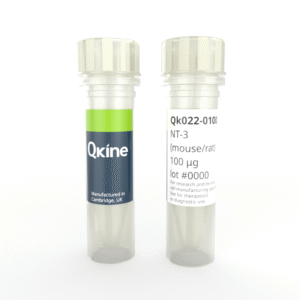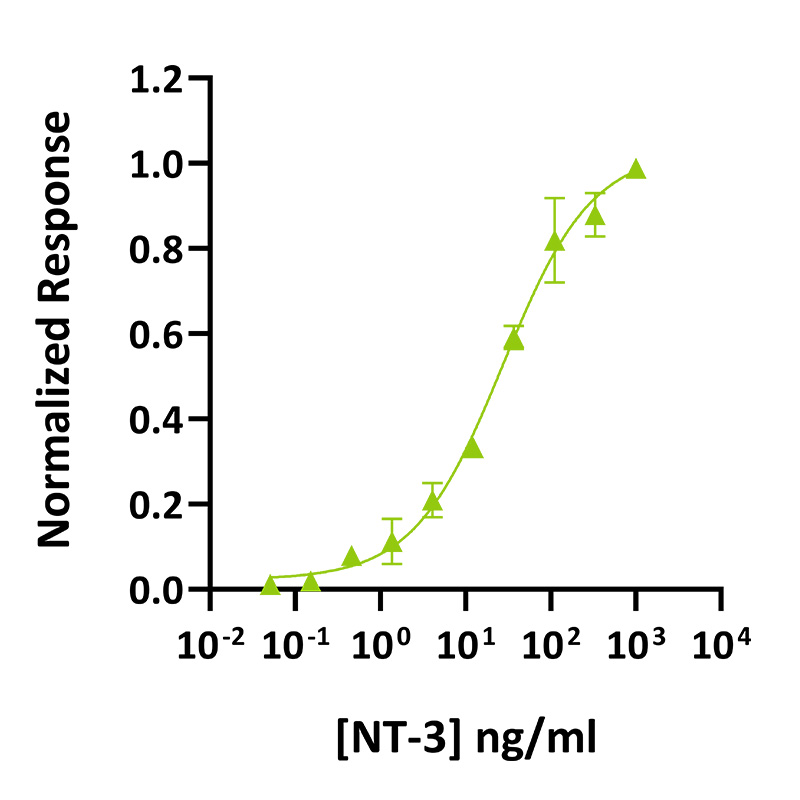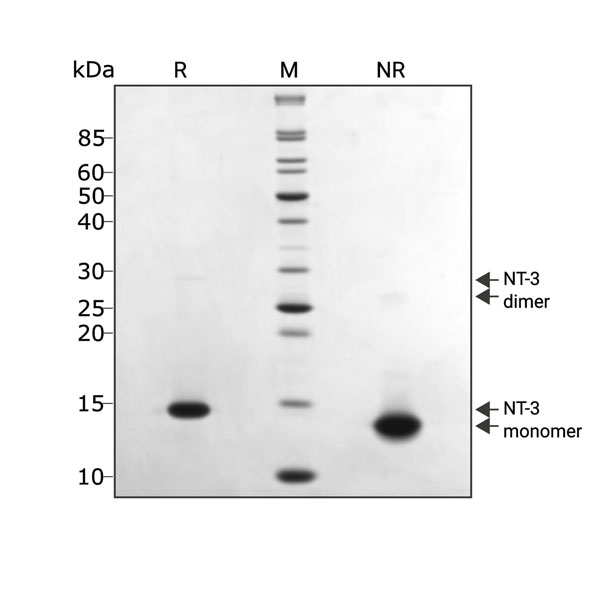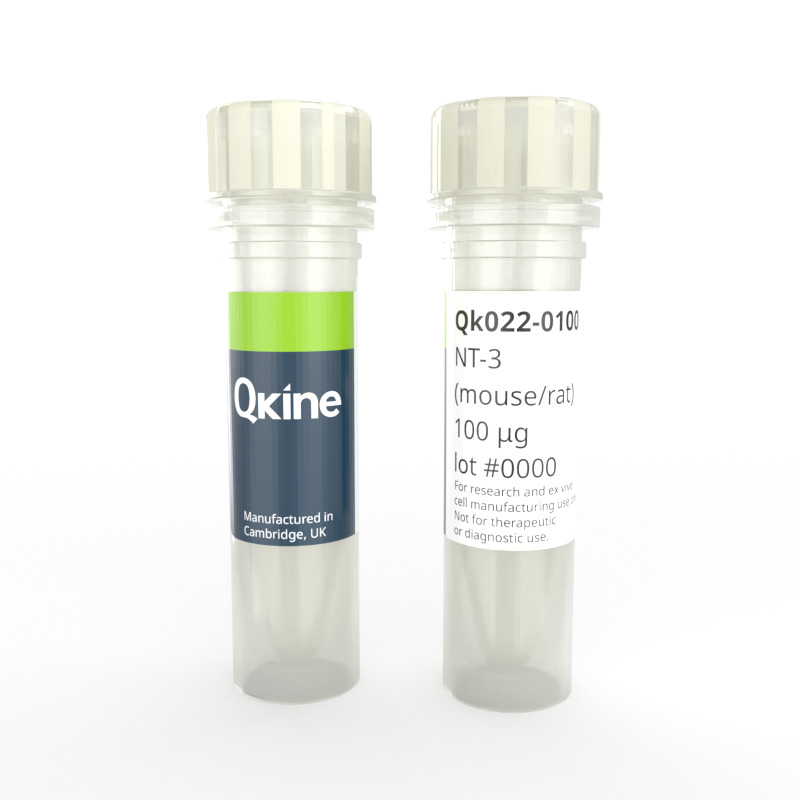 Recombinant mouse/rat NT-3 protein (Qk022)
Recombinant mouse/rat NT-3 protein (Qk022)Recombinant mouse/rat NT-3 protein (Qk022)
Price range: £290.00 through £3,600.00
Neurotrophin 3 (NT-3) protein is part of the neurotrophin family and plays a crucial role in embryonic development and the maintenance and neuroprotection of the adult nervous system. NT-3 protein is used in cell culture to promote the differentiation and survival of specific neural subpopulations in both the central nervous system and peripheral nervous system such as sensory neurons, cortical neurons, and oligodendrocytes. It is also involved in the maintenance of endothelial cells and myocardial cells.
Qkine mouse/rat NT-3 protein is a non-covalently linked homodimer with a molecular weight of 27.3 kDa, animal origin-free (AOF), carrier-free, tag-free, and non-glycosylated to ensure its purity with exceptional lot-to-lot consistency. It is suitable for the culture of reproducible and high-quality cortical neurons and oligodendrocytes.
In stock
Orders are typically shipped same or next day (except Friday).
Easy world-wide ordering, direct or through our distributors.
Price range: £290.00 through £3,600.00
Buy online with secure credit card or purchase order. For any questions, please email orders@qkine.com
Summary:
- High purity NT-3 protein (Uniprot: P20181)
- 27.3 kDa (dimer) 13.7 kDa (monomer)
>98%, by SDS-PAGE quantitative densitometry
Expressed in E. coli
Animal origin-free (AOF) and carrier protein-free
Manufactured in our Cambridge, UK laboratories
Lyophilized from acetonitrile, TFA
- Resuspend in 10 mM HCl (Reconstitution solution A) at >50 µg/ml, add carrier protein if desired, prepare single-use aliquots and store frozen at -20 °C (short-term) or -80 °C (long-term)
Featured applications:
Neural organoid growth and differentiation
Neural stem cell proliferation and neuronal differentiation
Neural stem cell research

NT-3 protein bioactivity was measured using a luciferase reporter assay in HEK293T cells co-transfected with the TrkA receptor. Cells were treated in triplicate with a serial dilution of Qk058 for 3 hours. Firefly luciferase activity was measured and normalized to the control Renilla luciferase activity. EC50 = 26.481 ng/ml (0.97 nM).
NT-3 protein migrates mainly as a single band at 13.7 kDa in non-reducing (NR) conditions and upon reduction (R). Purified recombinant protein (3 µg) was resolved using 15% w/v SDS-PAGE in reduced (+β-mercaptoethanol, R) and non-reduced (-β-mercaptoethanol, NR) conditions and stained with Coomassie Brilliant Blue R-250. A faint band visible at 27.3 kDa in NR and R conditions, corresponds to the non-covalently linked NT-3 dimer. No contaminating bands are visible.

Further quality assays
Mass spectrometry: single species with expected mass
Recovery from stock vial: >95%
Endotoxin: <0.005 EU/μg protein (below level of detection)
We are a company founded and run by scientists to provide a service and support innovation in stem cell biology and regenerative medicine. All our products are exceptionally high purity, with complete characterisation and bioactivity analysis on every lot.
Protein background
Neurotrophin 3 protein is a member of the neurotrophic factor or neurotrophin family which includes nerve growth factor (NGF), brain–derived neurotrophic factor (BDNF) and neurotrophin–4/5 (NT–4/5) [1-3].
NT3 protein plays a crucial role in the development and maintenance of the nervous system. During embryonic development, it is involved in the growth and survival of sensory neurons, as well as in the formation of connections between neurons [4]. In the adult nervous system, it has a neuroprotective role where it is involved in the maintenance and repair of sensory neurons [5]. It supports their long-term survival and function. It promotes the survival and differentiation of peripheral, sensory, and spinal motor neurons, and oligodendrocytes [6-11]. NT3 protein is also involved the heart development and myocardial vasculature [12,13].
NT3 protein is used in cell culture to promote the differentiation and survival of specific neural subpopulations in both the central nervous system and peripheral nervous system [2]. It is used to differentiate induced pluripotent stem cells into cortical neurons such as GABAergic and glutamatergic neurons along with BDNF, glial-derived neurotrophic factor (GDNF), insulin-like growth factor 1 (IGF-1) [14-17]. Cortical organoids also require NT-3 for maturation [18].
In addition, it is a main growth factor for the differentiation of oligodendrocytes along with platelet-derived growth factor (PDGF-AA) and IGF-1 [19,20]. Finally, it can also be used to maintain endothelial cells and myocardial cells [12,13] .
NT-3 is part of the cysteine knot family of growth factors that share high structural homology with other neurotrophins such as NGF and BDNF. It is structurally characterized by the presence of six conserved cysteine residues that result in each protomer forming a twisted four-stranded beta-sheet, with three intertwined disulfide bonds. Bioactive NT3 is a non-covalently linked 27.3 kDa homodimer of two 13.6 kDa monomers [21].
NT3 protein cDNA encodes a 257 amino acid residue precursor protein with a signal peptide and a proprotein that is proteolytically processed to generate the 119 amino acid residue mature NT-3. The amino acid sequence of mature NT-3 is identical in mice, rats, human and pigs. It exerts its effects by binding to two different classes of transmembrane receptors on the surface of neurons. The primary receptor for NT-3 is TrkC (tyrosine receptor kinase C), although it can also interact with the low-affinity p75 neurotrophin receptor. In certain cells, it is also known to activate TrkA and TrkB kinase receptors [2].
Neurotrophin 3 and other neurotrophins such as NGF and BDNF have been studied for their potential therapeutic applications in treating various neurodegenerative diseases, spinal cord injuries, and peripheral nerve injuries [22-24]. Research is ongoing on the potent ability of NT-3 protein to protect degenerating neurons and promote regeneration. This protein may also be a potential therapeutic target for depression and anxiety disorders by exerting its effect on neurotransmitters and the hypothalamic-pituitary-adrenal axis [24].
Mouse NT-3 has 100% homology to human and rat NT-3.
Our products are for research use only and not for diagnostic or therapeutic use. Products are not for resale.
For use in manufacturing of cellular or gene therapy products. Not intended for in vivo applications.

Receive an Amazon gift voucher when you leave us a review.
£25, $30 or €30 for reviews with an image and £10, $15 or €15 for reviews without an image
